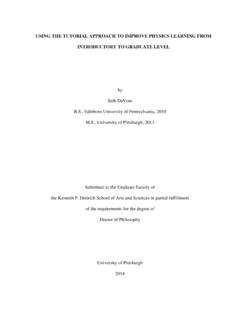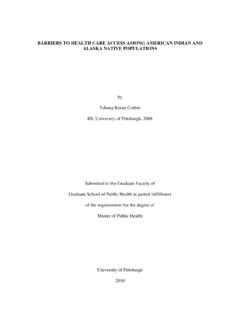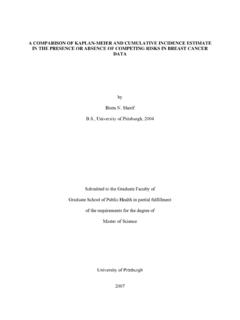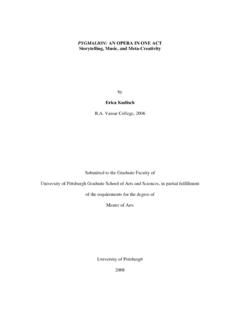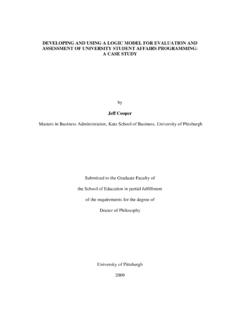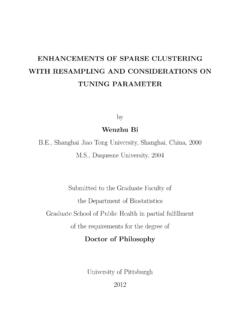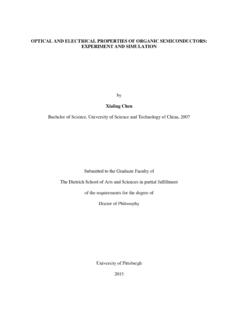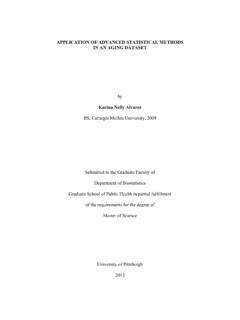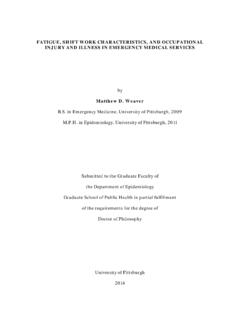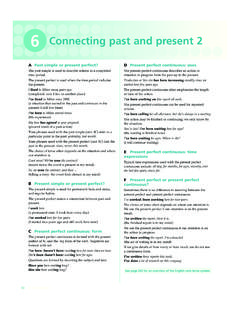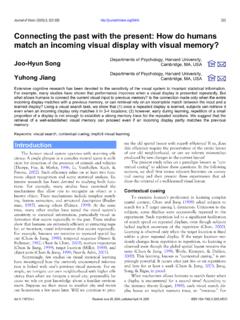Transcription of CONNECTING THE PAST TO THE PRESENT: STUDENT …
1 CONNECTING THE past TO THE present : STUDENT meaning making IN A middle school world history classroom by Michelle R. Anderson Education, Western Michigan University, 1995 Humanities, Central Michigan University, 2003 Submitted to the Graduate Faculty of University of Pittsburgh in partial fulfillment of the requirements for the degree of Doctorate of Education/Ed. D. University of Pittsburgh 2011 ii UNIVERSITY OF PITTSBURGH school OF EDUCATION This dissertation was presented by Michelle R. Anderson It was defended on August 15, 2011 and approved by Dr. Patricia Crawford, Associate Professor, Department of Instruction and Learning Dr. Meryl Lazar, Assistant Professor, Departmental of Instruction and Learning Dr. Amanda Thein, Assistant Professor, Department of Instruction and Learning Dissertation Advisor: Dr.
2 John Myers, Associate Professor, Department of Instruction and Learning iii Copyright by Michelle R. Anderson 2011 iv CONNECTING THE past TO THE present : STUDENT meaning making IN A middle school world history classroom Michelle R. Anderson, EdD University of Pittsburgh, 2011 This descriptive study investigates the ways that students in an Ancient history class make meaning of past events by relating them to their present lives and experiences. The study is grounded in theories of historical thinking, particularly focusing on the concepts of presentism and its usefulness for examining classroom teaching. The following two research questions guided the study: 1) How do students make connections between the past and present ? 2) When given the opportunity in writing and discussion, in what ways are students engaging with distant events in the past ?
3 The research site was a middle school in a medium-sized city located in the Midwest. Data was collected in the Fall of 2010 over the course of eight weeks during two units of study (Ancient Civilizations Review and Ancient Greece). The following data sources were collected: five audio-recorded classroom discussions and other instruction, twelve interviews with students and STUDENT assignments and journal entries. The analysis revealed two categories of the students thinking about the relevance of past events: (1) conflating the past with the present and the challenge of presentism, and (2) translating and adapting the past to the present . The data showed that some students viewed history from a presentist perspective that did not distinguish sufficiently between time periods.
4 However, many students also applied lessons from the past to their own lives by associating historical ideas and themes to their individual experiences, which was especially evident in the discussions. students tended to make sense of v history by assigning meaning to the concepts they were studying in a personal manner and by finding similarities between the past and present . vi TABLE OF CONTENTS PREFACE .. X STATEMENT OF THE PROBLEM ..2 RESEARCH QUESTIONS ..3 IMPORTANCE OF THE STUDY ..5 CONCLUSION ..6 LITERATURE REVIEW ..8 OVERVIEW OF HISTORICAL Knowledge of the past ..9 Interpretation of the past .. 11 meaning making IN history .. 12 Private meaning .. 13 Private meaning .. 16 ENGAGING LEARNERS IN THE history classroom .
5 19 Methods for supporting meaning making in the classroom .. 22 CONCLUSION .. 28 SUMMARY .. 29 METHODOLOGY .. 31 vii QUALITATIVE METHODS .. 31 THE RESEARCH SETTING AND PARTICIPANTS .. 32 DATA COLLECTION .. 35 Class discussions .. 37 Writing assignments .. 37 STUDENT 38 DATA ANALYSIS .. 39 The coding process .. 39 Trustworthiness of the data .. 42 SUMMARY .. 43 45 students CONNECTION BETWEEN THE past AND present .. 46 Conflating the past with the present and the challenge of presentism .. 46 Translating and adapting the past to the present .. 56 ENGAGING students IN THE STUDY OF history THROUGH WRITING AND DISCUSSION .. 67 Facilitating STUDENT thinking .. 67 students learning preferences .. 75 CONCLUSION .. 80 DISCUSSION .. 84 STUDENT CONNECTIONS AND meaning 86 The nature of the relationship students develop with the past .
6 86 Ms. Stewart s pedagogy and instructional strategies .. 88 viii SUGGESTIONS FOR SOCIAL STUDIES TEACHERS .. 90 SUGGESTIONS FOR FURTHER RESEARCH .. 94 CONCLUSION .. 97 APPENDIX A .. 98 APPENDIX B .. 105 APPENDIX C .. 107 APPENDIX D .. 110 APPENDIX E .. 112 APPENDIX F .. 113 BIBLIOGRAPHY .. 115 ix LIST OF TABLES Table 1. history education frameworks .. 40 Table 2. Revised coding structures .. 40 Table 3. Design structure .. 92 x PREFACE Beginning the dissertation journey seems an insurmountable task. Indeed it would be without the help and assistance of professors, colleagues, family and friends. I would like to thank my advisor, Dr. John Myers, for his assistance, insight and guidance. His constant push required me to become reflective in the process and advance my writing skills.
7 I am grateful to my committee, Dr. Patricia Crawford, Dr. Meryl Lazar, and Dr. Amanda Thein for their thoughtful feedback and constant encouragement. To my colleagues in the doctoral program at the University of Pittsburgh, particularly James Chisholm, Tim Oldakowski, Chantee McBride, Jason Fitzgerald and Jessica Stocks, thank you for your support and presence in this process. It is always nice to know that you are not alone! This dissertation would not have been possible without the help of family and friends who constantly inquired about the work I was doing, offered a listening ear and constant love and support. In particular, I would like to thank my parents, Robert and Donna Anderson, my brother Dan, sister-in-law Maggie, sister Jessica and brother-in-law Dave, Nancy Sundstrom, The Brandsma s, Lois Finkler, Margie Anderson and the Honeys for their love and encouragement.
8 I could not have done this without you. 1 INTRODUCTION history is boring. How many students have uttered these words over the years? Building students personal interest in history is considered one of the persistent and elusive challenges in the discipline. In my own career as a classroom teacher, changing students perception of history from boring to relevant and meaningful was a driving force in my instructional practices and remains a primary goal for teachers at all grade levels. However, too often teachers goal of making their curriculum relevant to students lives results in classroom teaching that might be fun but does not require learning disciplinary knowledge and thinking skills. In other words, the issue is not only about engaging students but doing so while also supporting their intellectual development.
9 Across disciplines, one of the key practices in research regarding STUDENT engagement is to help students see relevance in the curriculum and value to their lives (Newmann, 1992; Riggs & Gholar, 2009; Schreck, 2011; Tileston, 2004). In history education, making the past meaningful requires more than just the mere presentation and memorization of famous people and dates which is the typical way that history is taught in the (Wineburg, 2001). As Gary Gordon (2006) writes, If you don t use the specific subject matter in your life today, you probably remember very few of the very things about which you were tested. But if the class successfully 2 engaged your interests, you ve retained the broad concepts for use throughout your life. The trick is to provide as many moments of enthusiasm for learning as possible (p.)
10 81). As Gordon and other learning theorists have argued, making the curriculum relevant to students interests leads to long term understanding. However, making personal meanings about history in the classroom is a messy process. When confronting history , students may view it as strange and irrelevant or apply present day attributes when evaluating historical content. Both perceptions can create an environment where students may become frustrated with historical inquiry. In order to counter this, Gamoran and Nystrand (1992) suggest teachers ask students to personalize material students may make meaningful past to present connections. Teachers want students to see the big picture of history and apply those thoughts and ideas to their own lives (Wineburg, 2000).
